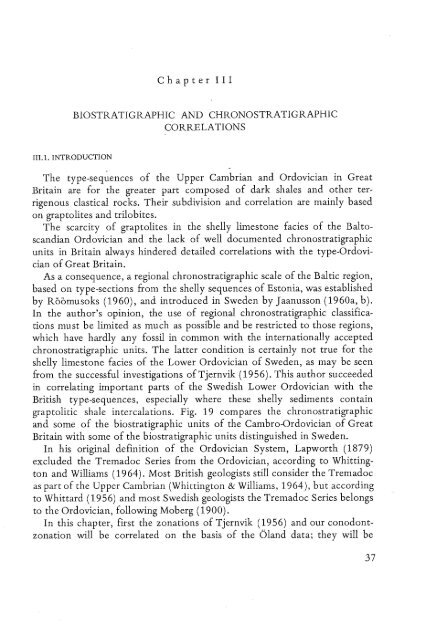UTRECHT MICROPALEONTOLOGICAL BUllETINS
UTRECHT MICROPALEONTOLOGICAL BUllETINS
UTRECHT MICROPALEONTOLOGICAL BUllETINS
Create successful ePaper yourself
Turn your PDF publications into a flip-book with our unique Google optimized e-Paper software.
BIOSTRATIGRAPHIC AND CHRONOSTRATIGRAPHIC<br />
CORRELATIONS<br />
The type-seq~ences of the Upper Cambrian and Ordovician in Great<br />
Britain are for the greater part composed of dark shales and other terrigenous<br />
clastical rocks. Their subdivision and correlation are mainly based<br />
on graptolites and trilobites.<br />
The scarcity of graptolites in the shelly limestone facies of the Baltoscandian<br />
Ordovician and the lack of well documented chronostratigraphic<br />
units in Britain always hindered detailed correlations with the type-Ordovician<br />
of Great Britain.<br />
As a consequence, a regional chronostratigraphic scale of the Baltic region,<br />
based on type-sections from the shelly sequences of Estonia, was established<br />
by Roomusoks (1960), and introduced in Sweden by Jaanusson (1960a, b).<br />
In the author's opinion, the use of regional chronostratigraphic classifications<br />
must be limited as much as possible and be restricted to those regions,<br />
which have hardly any fossil in common with the internationally accepted<br />
chronostratigraphic units. The latter condition is certainly not true for the<br />
shelly limestone facies of the Lower Ordovician of Sweden, as may be seen<br />
from the successful investigations of Tjernvik (1956). This author succeeded<br />
in correlating important parts of the Swedish Lower Ordovician with the<br />
British type-sequences, especially where these shelly sediments contain<br />
graptolitic shale intercalations. Fig. 19 compares the chronostratigraphic<br />
and some of the biostratigraphic units of the Cambro-Ordovician of Great<br />
Britain with some of the biostratigraphic units distinguished in Sweden.<br />
In his original definition of the OrdGvician System, Lapworth (1879)<br />
excluded the Tremadoc Series from the Ordovician, according to Whittington<br />
and Williams (1964). Most British geologists still consider the Tremadoc<br />
as part of the Upper Cambrian (Whittington & Williams, 1964), but according<br />
to Whittard (1956) and most Swedish geologists the Tremadoc Series belongs<br />
to the Ordovician, following Moberg (1900).<br />
In this chapter, first the zonations of Tjernvik (1956) and our conodontzonation<br />
will be correlated on the basis of the bland data; they will be
















